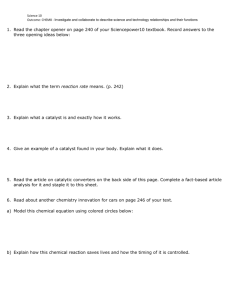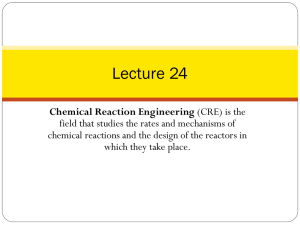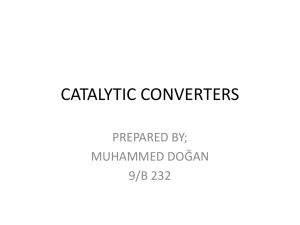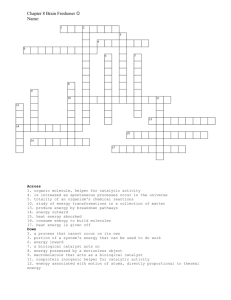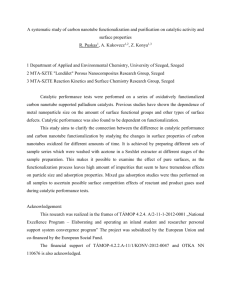2895-R - Bulgarian Chemical Communications
advertisement
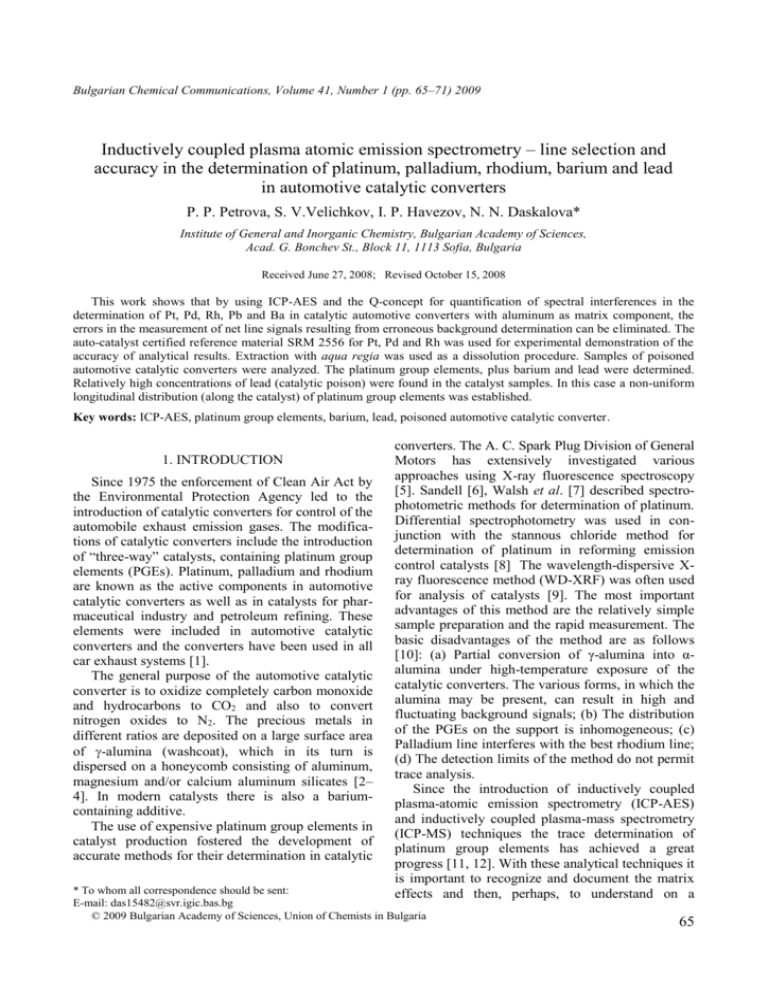
Bulgarian Chemical Communications, Volume 41, Number 1 (pp. 65–71) 2009 Inductively coupled plasma atomic emission spectrometry – line selection and accuracy in the determination of platinum, palladium, rhodium, barium and lead in automotive catalytic converters P. P. Petrova, S. V.Velichkov, I. P. Havezov, N. N. Daskalova* Institute of General and Inorganic Chemistry, Bulgarian Academy of Sciences, Acad. G. Bonchev St., Block 11, 1113 Sofia, Bulgaria Received June 27, 2008; Revised October 15, 2008 This work shows that by using ICP-AES and the Q-concept for quantification of spectral interferences in the determination of Pt, Pd, Rh, Pb and Ba in catalytic automotive converters with aluminum as matrix component, the errors in the measurement of net line signals resulting from erroneous background determination can be eliminated. The auto-catalyst certified reference material SRM 2556 for Pt, Pd and Rh was used for experimental demonstration of the accuracy of analytical results. Extraction with aqua regia was used as a dissolution procedure. Samples of poisoned automotive catalytic converters were analyzed. The platinum group elements, plus barium and lead were determined. Relatively high concentrations of lead (catalytic poison) were found in the catalyst samples. In this case a non-uniform longitudinal distribution (along the catalyst) of platinum group elements was established. Key words: ICP-AES, platinum group elements, barium, lead, poisoned automotive catalytic converter. 1. INTRODUCTION Since 1975 the enforcement of Clean Air Act by the Environmental Protection Agency led to the introduction of catalytic converters for control of the automobile exhaust emission gases. The modifications of catalytic converters include the introduction of “three-way” catalysts, containing platinum group elements (PGEs). Platinum, palladium and rhodium are known as the active components in automotive catalytic converters as well as in catalysts for pharmaceutical industry and petroleum refining. These elements were included in automotive catalytic converters and the converters have been used in all car exhaust systems [1]. The general purpose of the automotive catalytic converter is to oxidize completely carbon monoxide and hydrocarbons to CO2 and also to convert nitrogen oxides to N2. The precious metals in different ratios are deposited on a large surface area of -alumina (washcoat), which in its turn is dispersed on a honeycomb consisting of aluminum, magnesium and/or calcium aluminum silicates [2– 4]. In modern catalysts there is also a bariumcontaining additive. The use of expensive platinum group elements in catalyst production fostered the development of accurate methods for their determination in catalytic converters. The A. C. Spark Plug Division of General Motors has extensively investigated various approaches using X-ray fluorescence spectroscopy [5]. Sandell [6], Walsh et al. [7] described spectrophotometric methods for determination of platinum. Differential spectrophotometry was used in conjunction with the stannous chloride method for determination of platinum in reforming emission control catalysts [8] The wavelength-dispersive Xray fluorescence method (WD-XRF) was often used for analysis of catalysts [9]. The most important advantages of this method are the relatively simple sample preparation and the rapid measurement. The basic disadvantages of the method are as follows [10]: (a) Partial conversion of γ-alumina into αalumina under high-temperature exposure of the catalytic converters. The various forms, in which the alumina may be present, can result in high and fluctuating background signals; (b) The distribution of the PGEs on the support is inhomogeneous; (c) Palladium line interferes with the best rhodium line; (d) The detection limits of the method do not permit trace analysis. Since the introduction of inductively coupled plasma-atomic emission spectrometry (ICP-AES) and inductively coupled plasma-mass spectrometry (ICP-MS) techniques the trace determination of platinum group elements has achieved a great progress [11, 12]. With these analytical techniques it is important to recognize and document the matrix effects and then, perhaps, to understand on a * To whom all correspondence should be sent: E-mail: das15482@svr.igic.bas.bg © 2009 Bulgarian Academy of Sciences, Union of Chemists in Bulgaria 65 P. P. Petrova et al.: Inductively coupled plasma atomic emission spectrometry fundamental level and to control and eliminate them. Matrix effects in ICP-AES and ICP-MS may be divided into two basic categories: matrix induced spectral overlap problems and matrix induced signal intensity changes [13–15]. The analysis of Pt, Pd and Rh by ICP-MS or ICP-AES is complicated by the existence of interferences [16, 17]. Examination of these interferences is critical for selection of most suitable isotopes for isotope dilution mass spectrometry and for assessing whether any additional interference removal measures are required for the analysis. The interferences can potentially be problematic in the determination of PGEs [18–21]. The possibilities for limitation and correction of the interferences in the determination of PGEs by ICP-MS were discussed as follows: Matrix removal by exchange column [22–25], charcoal [26], silica [27–29], plastic foams and polymers [30–31]; Application of high resolution mass spectrometry (HR-ICP-MS) – there is no commercially available HR-ICP-MS, which can separate the oxide interferences on the PGEs [32]; The influence of plasma operating conditions by varying nebulizer gas flow rates, cool plasma techniques and chilled spray chambers [33, 34]; Mathematical corrections [35]; Post-plasma techniques, including the use of collision and reaction cells [36]. These techniques do not influence the plasma parameters and the corresponding operating conditions [36]. The ICP-AES methods also possess the possibilities for simultaneous determination of PGEs [37]. Although the concentrations of PGEs in automotive catalytic converters are relatively high, the use of both techniques ICP-MS and ICP-AES would allow the methods to expand to applications of low concentration level analysis. Several dissolution procedures of automotive catalyst materials were developed and their possibilities were discussed in [38]. The present paper deals with the ICP-AES determination of platinum, palladium, rhodium, barium and lead in samples taken out of poisoned automotive catalytic converters. All modern converters contain also barium in order to reduce the effect of sulfur poisoning. So in the presence of barium the activity of catalytic converters increases. The general purpose is to ensure the accurate measurement of the net line signals, i.e. the subtraction of the signal, generated by the back-ground at analyte wavelength (λa) from the total signal before manipulation of the net signal to derive an analyte concentration. The matrix constituent in this case is aluminium. The question of what it actually is, why it is such severe problem, and what progress has been made in recent 66 years to cope with it, remains. This problem is of primary importance, because the spectral interferences in ICP-AES affect the accuracy of analytical results and the magnitude of the true detection limits. The background under a spectral line cannot be measured directly. An elementary calculation illustrated the importance of correct background subtraction and showed the magnitude of the errors in net signals resulting from erroneous background determination [11]. An interfering line signal, in the presence of a given matrix, has to be considered as a contribution to the background that can be measured only with a far greater uncertainty than continuous background. It was this insight that prompted the introduction of the concepts of “true detection limit” (CL, true) [13, 39–42] and the “common detection limit” (CL) for pure solvent [41]. In the case of a single interfering line the true detection limit (CL, true) is represented by Eqn. (1) [40]: CL, true = 0.4×QI(a)CI + CL, conv (1) CL, conv = 220.01RSDBL[BEC + QI (a)CI + + QW(a)CI] (2) where: CI is matrix concentration; CL, conv – conventional detection limits; QI(a) – values for line interference [QI(λa) = SI(a)/SA], defined as interferent to analyte sensitivity ratio at the peak wavelength (a) of prominent lines of analytes (Pt, Pd, Rh, Ba, Pb); QW(a) – values for wing background interference [QW(Δλa) = SW(a)/SA], defined as wing background to analyte sensitivity ratio in the spectral window (a). The use of the symbol (a) instead of (a) expresses that [QW(a)] refers to the overall level in the spectral window (a) viewed and not specifically to (a), as happens with the QI(a) value; RSDBL – relative standard deviation of the total background signal in the presence of matrix; BEC – background equivalent concentration in the pure solvent. The detection limit of analytes in pure solvent (or dilute acid) is defined by Eqn. (3) [41]: CL = 220.01RSDBBEC (3) where RSDB is the relative standard deviation of the background signal in the presence of pure solvent. To fulfil the general purpose of the paper the following data have been compiled: 1. Quantification of the spectral interferences by using Q-concept, as proposed by Boumans and Vrakking [40–41] for line interference [QI(a)] and for wing background interference [QW(a)] for relevant sets of analysis lines and aluminium as interferent; P. P. Petrova et al.: Inductively coupled plasma atomic emission spectrometry 2. Choice of the “best” analysis lines for determination of PGEs, lead and barium in the presence of aluminium matrix; 3. Measurement of the true detection limits, by using the “true detection limit” criterion [40]. scanning mode of the spectrometer with step size 3.0 pm and integration time of 1 s. The total background signal is defined by Eqn. (4) [41]: 2. EXPERIMENTAL where: - XB is the solvent blank (due to source and solvent); - XW(Δλa) – the wing background level with respect to the solvent blank for aluminium as interferent; - XI(λa), – the net interfering signals with respect to the wing background level XW(Δλa) of aluminium as interferent. By using analysis and scanning modes of the monochromator the following signals were measured: XA, XB, XW(Δλa), XI(λa). The measured signals were reduced to sensitivities: sensitivity of analysis line [SA] defined as the net line signal [XA] per unit of analyte concentration [CA]; interferent sensitivities [SW(Δλa)] and [SI(λa)], defined as interferent signals [XW(Δλa)] and [XI(λa)], respectively, per unit interferent concentration [CI]. The sensitivities were used for calculation of Q-values for wing background interference [QW(λa) = SW(Δλa)/SA], Q-values for line interference [QI(λa) = SI(λa)/SA], [BECW = QW(Δλa)×CI] and [BECI(λa) = QI(λa)×CI]. 2.1. Instrumentation The experiments were performed with Jobin Yvon ULTIMA 2 equipment (Longjumeau, France), whose characteristics are specified in Table 1. The operating conditions are shown in Table 2. The Mg II 280.270 nm/Mg I 285.213 nm line intensities ratio was measured to characterize the robustness of the operating conditions in the plasma [43, 44]. The excitation temperature (Texc) was evaluated by the Boltzmann plot method [45] using titanium lines. Under these experimental conditions higher net line signals and lower detection limits were obtained [46]. Table 1. Specifications of the spectrometer and ICP source. Monochromator Mounting Grating Wavelength range Entrance slit Exit slit Practical spectral bandwidth Detectors Rf generator Frequency Power output Nebulizer Spray chamber Plasma torch Pump JY ULTIMA 2 (Jobin Yvon, France) Czerny-Turner, focal length 1 m Holographic, 2400 grooves·mm–1 first and second order 0.015/0.02 mm 0.02/0.08 mm 5 pm in the 2-nd order from 160 nm to 320 nm; 10 pm in the 1-st order from 320 to 800 nm High Dynamic Detectors based on PMT’s Solid state RF 40.68 MHz 40.68 MHz 0.5–1.55 kW Meinhard, concentric glass JY Glass cyclonic spray chamber fully demountable torch Peristaltic, two channels, twelve-roller Table 2. Operating conditions with the 40.68 MHz ICP JY ULTIMA 2 (Jobin Yvon, France) equipment. Incident power /(kW) Outer argon flow rate, l·min–1 Auxiliary gas flow rate, l·min–1 Sheath gas flow rate, l·min–1 Liquid uptake rate, ml·min–1 Carrier gas flow rate, ·l/min–1 Nebulizer pressure flow Mg II 280.270 nm /Mg I 285.213 nm line intensities ratio Excitation temperature 1.00 13 0 0.2 1.0 0.4 3.2 bar 10.4 7300 K Quantitative information about the type of the spectral interferences was derived from wavelength scans around the candidate (prominent) analysis lines of Pt, Pd, Rh, Pb and Ba in the presence of aluminium as interferent. The scans were made in a XBL = XB + XW(Δλa) + XI(λa) (4), 2.2. Reagents, test solutions and certified reference material Reagents of highest purity grade were used: 30% HCl and 65% HNO3 (Suprapur, Merck) and redistilled water from quartz apparatus. Stock solutions of the analyte (1 mg·ml–1 Pt, Pd, Rh, Pb and Ba) were prepared from Merck ICP-AES mono-element standard solutions. Q-values were measured by using the following test solutions: 10 g·ml–1 for each of the analytes in 3% hydrochloric acid and 2 mg·ml–1 aluminium in 3% hydrochloric acid as interferent. The recycled auto-catalyst certified reference material SRM 2556 for Pt, Pd and Rh with mean values and uncertainties at a 95% confidence interval was used for experimental demonstration of the accuracy of analytical results. In the certificate it is indicated that a sample of 0.1 g or a larger one is provided as a representative sub-sample of this material. 2.3. Sampling Samples taken out of poisoned automotive catalytic converters: (a) From the front section of the catalyst; (b) From the rear part of the catalyst; (c) Soot deposits on the catalyst’s front. 67 P. P. Petrova et al.: Inductively coupled plasma atomic emission spectrometry 2.4. Decomposition procedure 1 g of the catalyst samples was weighed in a 50 ml beaker. 15 ml of freshly prepared mixture of acids (5 ml conc. HNO3 + 15 ml conc. HCl) was added to the sample and the beaker was covered with a watch glass. The sample was left to stand for 1 h at room temperature in order to prevent vigorous reactions. After that, the sample was heated for 6 h on a water bath and allowed to cool down slowly to room temperature. The content of the beaker was transferred quantitatively into a 100 ml volumetric flask and filled up to the mark with re-distillated water. The undissolved material (γ-alimina + silicates) has settled down and the supernatant solution was subjected to analysis by ICP-AES. The volume of the solid residue is less than 0.4% of the final volume. 2.5. Calibration procedures The analytical evaluation function is assumed to be a straight line passing through the origin. Spectral interferences affect the intercept, if the curve is plotted on a linear scale. Multiplicative interferences affect the slope of a calibration curve [12]. The correct calibration from the point of view of the spectral interferences requires a correct background subtraction by using the background signal below the analysis line. The correct calibration from the point of view of multiplicative interferences means a precise matching of the acid and matrix contents both in the reference and in the sample solutions. ICP-AES is not free from acid matrix interferences [47–49]. The reference solutions for the determination of the analytes were prepared on the basis of a blank containing the acids used for digestion (Section 2.4). The matrix blank contains the acid blank. 3. RESULTS AND DISCUSSION 3.1. Detection limits in pure solvent The detection limits of the analytes in pure solvent (or diluted acids) were calculated by Eqn. (3) using four prominent lines for Pt, Pd, Pb, Ba and 14 prominent lines for rhodium. The prominent lines in column 1 of Table 3 follow the sensitivity order the analytes in pure solvent in accordance to Boumans ICP-Line Coincidence Tables [50]. The obtained detection limits under our experimental conditions are listed in Table 3, column 2. Table 3 shows that the most prominent lines under our experimental conditions (Table 2): Pt II 203.646 nm, Pd II 229.651 nm and Rh II 233.477 nm. The following detection limits are obtained: 6.4 ng·ml–1 (Rh), 7 ng·ml–1 (Pt) and 11 ng·ml–1 (Pd). 68 Table 3. Detection limits in pure solvent. The most prominent lines, nm Detection limits in solution, ng·ml–1 Pt II 214.423 (2) Pt II 203.646 (1) Pt II 204.937 (4) Pt I 265.945 (3) Pd I 340.458 (2) Pd I 363.470 (4) Pd II 229.651 (1) Pd I 324.270 (3) Rh II 250.429 (13) Rh I 250.509*(10) Rh I 250.384*(13) Rh II 233.477 (1) Rh II 249.077 (2) Rh I 343.489 (4) Rh II 252.053 (3) Rh I 369.236 (7) Rh II 246.104 (5) Rh II 251.103 (6) Rh II 242.711 (8) Rh I 339.682 (11) Rh I 352.802 (12) Rh I 370.091 (14) Rh I 228.857 (9) Pb II 220.353 (1) Pb I 216.999 (2) Pb II 261.418 (3) Pb I 283.306 (4) Ba II 455.403 (1) Ba II 493.409 (1) Ba II 233.527 (1) Ba II 230.424 (1) 7.3 7.0 24 14 13.4 37.0 11.0 25.0 92.0 28.0 45.0 6.4 7.7 12.3 11.6 19.7 14.0 18.8 21.0 30.0 37.0 53.0 22.0 6.7 23 30.0 36.0 0.3 0.3 0.3 0.3 * These lines are not listed in Boumans‘ ICP Tables [50]. They are taken from Harrison’s, M.I.T. Wavelength Tables [51]. 3.2. Line selection in the presence of aluminium as matrix The Q-concept was used for quantifying different types of spectral interference [40]. A distinction was made between Q-values for line interference [QI(λa)] and Q-values for wing background interferences [QW(Δλa)] around a relevant set of analysis lines. Table 4 lists QW(Δλa) and QI(λa) values for prominent lines of Pt, Pd, Rh, Pb and Ba in the presence of 2 mg·ml–1 aluminium as interferent. The optimum line selection for trace analysis requires the choice of prominent lines that are free from line interfer-ence and negligibly influenced by wing background interference in the presence of aluminium as matrix. The results of Table 4 show the following: (i) The most prominent lines of lead are influenced by line interference in the presence of aluminium as interferent. The “best” analysis line is Pb II 261.418. This line is free of line interference; (ii) The most prominent lines of Pt, Pd, Rh and Ba are free of line interference and were selected as the “best” analysis lines. P. P. Petrova et al.: Inductively coupled plasma atomic emission spectrometry The selected analysis lines are printed in bold. Table 4. QW(a) and QI(a) for prominent lines of Pt, Pd, Rh, Ba and Pb in the presence of aluminium as matrix element. Analysis line, nm Interferents QW(Δλa) QI(λa) Al Al Al Al Al Al Al Al Al Al Al Al Al Al Al Al Al Al Al Al Al Al Al 7.2×10–4 0 2.310–4 0 0 0 0 0 0 0 0 0 0 2.610–4 2.610–4 0 0 0 0 0 0 0 0 0 Pt II 203.646 Pt II 214.423 Pt I 265.945 Pt II 204.9168 Pd II 229.651 Pd I 340.458 Pd I 324.270 Pd I 363.470 Rh II 233.477 Rh II 249.077 Rh II 252.053 Rh I 343.489 Pb II 220.353 Pb II 220.353 Pb II 261.418 Pb I 283.306 Ba II 455.403 Ba II 493.409 Ba II 233.527 Ba II 493.409 Pb II 261.418 Pb I 283.306 Ba II 455.403 1.010–4 1.710–3 2.210–3 0 0 0 0 0 0 0 0 6.510-–5 6.510–5 4.0×10–5 0 0 0 0 0 4.010–5 0 0 3.3. Detection limits in the determination of Pt, Pd, Rh, Pb and Ba in catalytic automotive converters Table 5 summarizes the selected analysis lines from Table 4 and the true detection limits in [%]. The detection limits, obtained under our experimental conditions, satisfied the requirements of the practice. Therefore, ICP-AES can be used for determination of the Pd, Pt, Rh, Ba and Pb contents in samples of catalytic automotive converters. Table 5. Selected analysis lines and detection limits (in %) with respect to the dissolved solid sample. Best analysis lines, nm Detection limits with respect to the dissolved solid sample, % Pt II 203.646 Pd II 229.651 Rh II 233.477 Pb II 261.418 Ba II 455.403 7.010–5 2.010–4 6.410–4 3.010–4 3.010–6 3.4. Analysis of a sample of certified reference material The certified reference material SRM 2556 (for Pt, Pd and Rh) was dissolved in accordance with the decomposition procedure, described in Section 2.4. The final solution was introduced into the ICP for analysis. The results in the determination of Pt, Pd and Rh contents were compared to the corresponding certified values (Table 6). The selected pro- minent lines were used as analysis lines (column 1). The confidence intervals of the mean values for five replicates (n = 5) and statistical confidence P = 95% were calculated [52–54]. Using Student’s criterion, no statistical differences between the experimental (column 2) and certified values (column 3) were found. Table 6. Contents of Pt, Pd and Rh (in %) obtained by JY ULTIMA 2 ICP-AES (n = 5 replicates) in the analysis of certified reference material SRM 2656 (column 2) and the corresponding certified values (column 3). Analysis line, nm JYULTIMA 2 ICP-AES Certified values Concentration, (%) Concentration, (%) X ΔX X X (n = 5, P = 95%) 0.0692 0.007 0.0324 0.003 0.00515 0.001 Pt II 203.646 Pd II 229.651 Rh II 233.477 0.06974 0.0023 0.0326 0.0016 0.00512 0.0005 3.5. Analysis of samples of damaged catalytic automotive converters A damaged catalytic automotive converter was submitted to us for analyses from Citroēn Company. The analytical task requires the determination of Pt, Pd, Rh, Ba and Pb contents in the material, sampled from different parts of damaged catalytic automotive converter (Section 2.3). The decomposition method is described in Section 2.4. Table 7 lists the concentration of Pt, Pd, Rh, Ba and Pb in the material, sampled from different pats of catalytic converter. The confidence intervals of the mean values for five replicates (n = 5) and statistical confidence level P = 95% were calculated [52–54]. Table 7. Content of Pt, Pd, Rh, Ba and Pb material sampled from different sections of the damaged catalytic automotive converter. Type of sample Catalyst from the deposit of converter Catalyst from the inlet of converter Catalyst from the outlet of converter Content of elements, % Pt Pd Rh Ba Pb 0.07 0.007 0.30 0.007 0.014 0.003 0.16 0.03 0.18 0.003 0.20 0.007 0.20 0.007 0.010 0.003 0.60 0.03 0.14 0.003 0.34 0.007 0.16 0.007 0.008 0.003 0.73 0.03 0.02 0.003 The results of Table 7 show that relatively high concentrations of lead (catalytic poison) were found in the catalyst samples. The conclusion based on the analytical results was that this automotive catalytic converter was deactivated as a result of utilization of leaded-motor fuel. The catalytic poisoning with lead causes a non-uniform longitudinal distribution (along the catalyst bed) of platinum group elements and 69 P. P. Petrova et al.: Inductively coupled plasma atomic emission spectrometry barium. This is in accordance with the measurements of the catalytic activity of the analyzed catalytic converters: the higher concentrations of lead correspond to a lower catalytic activity and consequently a greater mass of soot deposits at the converters inlet (up to complete blocking of the catalysts). 4. CONCLUSIONS This work has shown that, in the analysis of catalytic automotive converter, quantitative information on the spectral interferences is essential. The Qconcept, as proposed by Boumans and Vrakking [40–41], was used for quantification of the spectral interferences in the presence of aluminium as matrix component (Table 4). By using a spectrometer with practical spectral bandwidth of 5 pm (Table 1), it is possible to select the “best” analysis lines for Pt, Pd, Rh, Pb and Ba, which are free from line interference (Table 4). In this case, the detection limits (Table 5) do not significantly deteriorate when compared to the detection limits obtained in pure solvent (Table 3). Samples of a damaged catalytic automotive converter were analyzed. The results show that relatively high concentrations of lead (catalytic poison) were found in the catalyst samples. Hence, this automotive catalytic converter is deactivated as a result of utilization of leaded-motor fuel. The catalytic poisoning with lead causes a non-uniform longitudinal distribution (along the catalyst bed) of platinum group elements and barium. 5. REFERENCES 1. H. E. Beary, P. J. Paulsen, Anal. Chem., 67, 3193 (1995). 2. A. I. Kindon, R. F. Davis., in: Engineered Materials Handbook, Vol. 4: Ceramic and Glasses, S. J. Schneider (Technical Chairman), ASM International, Metal park, OH, 1991. 3. H. E. Taylor, R. A. Huff, A. Montaser, in: Inductively Coupled Plasma Mass Spectrometry, A. Montaser (Ed.), J. Wiley, New York, 1998. 4. C. J. Jones, D- and F-Block Chemistry, Royal Society of Chemistry, Cambridge, 2001. 5. R. Van Dyne, Summary of Several X-Ray Fluorescence Procedures for Measuring Pt and Pd in Catalyst Materials, Report to ASTM Committee E-32-03 at Philadelphia Meeting, 11 March, 1975. 6. E. B. Sandell, Calorimetric Determination of Traces of Metals, 3rd Edn., Interscience, New York, 1959. 7. T. J. Walsh, A. Hansman, in: Treatise on Analytical Chemistry, Vol. 8, I. M. Kolthoff, P. J. Elving (Eds.), Interscience, New York, 1963. 8. S. Kallmann, Talanta, 23, 579 (1976). 9. S. Kallmann, P. Blumberg, Talanta, 27, 827 (1980). 70 10. O. G. Borisov. D. M. Coleman, K. A. Oudsema, R. O. Carter, J. Anal. At. Spectrom., 12, 239 (1997). 11. P. W. J. M. Boumans, in: Basic Concepts and Characteristics of ICP-AES, Inductively Coupled Plasma Emission Spectroscopy, Part 1: Methodology, Instrumentation and Performance, P. W. J. M. Boumans (Ed.), Wiley, New York, 1987, Chapter 4, p. 100. 12. D. S. Bollinger, A. J. Schleisman, in: Plasma Source Mass Spectrometry: New Developments and Applications, G. Holland, S. D. Tanner (Eds.), Royal Society of Chemistry, Cambridge, UK, 1999. 13. P. W. J. M. Boumans, Fresenius Z. Anal. Chem., 324, 397 (1986). 14. P. W. J. M. Boumans, in: Line Selection and Spectral Interferences, Inductively Coupled Plasma Emission Spectroscopy, Part 1: Methodology, Instrumentation and Performance, P. W. J. M. Boumans (Ed.), Wiley, New York, 1987, Ch. 7, p. 358. 15. S. H. Tan, G. Horlick, J. Anal. At. Spectrom., 2, 745 (1987). 16. L. A. Simpson, M. Thomsen, B. J. Alloway, A. Parker, J. Anal. At. Spectrom., 16, 1375 (2001). 17. W. Pretorius, D. Chipley, K. Kyser, B. Helmstaedt, J. Anal. At. Spectrom., 18, 302 (2003). 18. H. P. Longerich, G. A., Jenner, B. J Fryer, S. E. Jackson, Chem. Geol., 83, 105 (1990). 19. M. Krachler, A. Alimonte, F. Pettrucci, K. J. Irgolic, F. Forastiere, S. Caroli, Anal. Chim. Acta, 363, 1 (1998). 20. F. Pettrucci, B. Bocca, A. Alimonte, S. Caroli, J. Anal. At. Spectrom., 15, 525 (2000). 21. L. A Simpson., R. Hearn, T. Catterick, J. Anal. At. Spectrom., 19 1244 (2004). 22. P. Di, D. E. Davey, Talanta, 42, 685 (1995). 23. M. Grote, A. Kettrup, Anal. Chim. Acta, 201, 95 (1987). 24. I. Jarvis, M. M. Totland, K. E. Jarvis, Analyst, 122, 19 (1997). 25. D. G. Pearson, S. J. Woodland, Chem. Geol., 165, 87 (2000). 26. G. E. M. Hall, J. C. J. Pelchat, J. Anal. At. Spectrom., 8, 1059 (1993). 27. T. Schilling, P. Schramel, B. Michalke, G. Knapp, Mikrochim. Acta, 116, 83 (1994), 28. M. Schuster, M. Schwarzer, At. Spectrosc., 19, 121 (1998). 29. P. Liu, Q. Pu, Z. Su, Analyst, 125, 147 (2000). 30. L. Jones, N. Iris, K. L Koch, Anal. Chim. Acta, 182, 61 (1986). 31. D. Kundu, S. K. Roy, R. C. Denny, M. J. K. Thomas, Revised Edition of Vogels Textbook of Quantitative Chemical Analysis, 6th edn., Prentice Hall, 2000, p. 76. 32. J. Mendham, J. D. Barnes, R. C. Denny, M. J. K. Thomas, Revised Edition of Vogels Texbook of Quantitative Chemical Analysis, 6-th edn., Prentice Hall, 2000. 33. J. W. H. Lam, J. McLaren, J. Anal. At. Spectrom., 5, 419 (1990). 34. E. R. Denoyer, At. Spectrosc., 112, 215 (1991). P. P. Petrova et al.: Inductively coupled plasma atomic emission spectrometry 35. G. Hann, K. Kanitsar, K. Korllensperger, G. Stingeder, J. Anal. At. Spectrom., 16, 1057 (2001). 36. A. Montaser, M. G. Minnich, J. A. McLean, H. Liu, J. A Caruso, C. W. McLeod, in: Inductively Coupled Plasma Mass Spectrometry, A. Montaser (Ed.), Wiley-VCH, 1997. 37. L. Bencs, K. Revindra, R. Van Greken, Spectrochim. Acta Part B, 58, 1723 (2003). 38. J. A. Brown, F. W. Kunz, R. K Belitz, J. Anal. At. Spectrom., 6, 393 (1991). 39. P. W. J. M. Boumans, J. Anal. At. Spectrom., 8, 767 (1993). 40. P. W. J. M. Boumans, J. J. A. M. Vrakking, Spectrochim. Acta Part B, 43, 69 (1988) 41. P. W. J. M. Boumans, J. A. Tielrooy, F. J. M. J. Maessen, Spectrochim. Acta Part B, 43, 173 (1988). 42. P. W. J. M. Boumans, Anal Chem., 66, 459A (1994). 43. J. M. Mermet, Anal. Chim. Acta, 250, 85 (1991). 44. J. Dennaud, A. Howes, E. Poussel, J. M. Mermet, Spectrochim. Acta Part B, 56, 101 (2001). 45. J. M. Mermet, in: Spectroscopic Diagnostics: Basic Concepts, Inductively Coupled Plasma Emission Spectroscopy, Part 2: Application and Fundamentals, 46. 47. 48. 49. 50. 51. 52. 53. 54. P. W. J. M. Boumans (Ed.), Wiley, New York, 1987, Ch. 10, p. 353. N. Velitchkova, S. Velichkov, N. Daskalova, Spectrochim. Acta Part B, (submitted). E. G. Chudinov, I. I. Ostroukhova, G. V. Varvanina, Z. Anal. Chem., 335, 2533 (1989). I. B. Brenner, J. M. Mermet, I. Segal, J. L. Long, Spectrochim. Acta Part B, 50, 323 (1995). J. L. Todolí, J. M. Mermet, Spectrochim. Acta Part B, 54, 895 (1999). P. W. J. M. Boumans, Line Coincidence Tables for Inductively Coupled Plasma Emission Spectrometry, Pergamon, Oxford, 1980. G. R Harrison, M.I.T. Wavelength Tables, M.I.T. Press, Cambridge, MA, 1969. V. V. Nalimov, The Application of Mathematical Statistics to Chemical Analysis, Pergamon, Oxford, 1963. J. Mendel, The Statistical Analysis of Experimental Data, Wiley, New York, 1964. K. Doerffel, Statistic in the Analytical Chemistry, VEB Deutscher Verlag für Grundstoffindustrie, Leipzig, 1984 (in German). АТОМНА ЕМИСИОННА СПЕКТРОМЕТРИЯ С ИНДУКТИВНО СВЪРЗАНА ПЛАЗМА – ИЗБОР НА АНАЛИТИЧНИ ЛИНИИ И ТОЧНОСТ ПРИ ОПРЕДЕЛЯНЕ НА ПЛАТИНА, ПАЛАДИЙ, РОДИЙ, БАРИЙ И ОЛОВО В АВТОМОБИЛНИ КАТАЛИЗАТОРИ П. П. Петрова, С. В. Величков, Ив. П. Хавезов, Н. Н. Даскалова* Институт по обща и неорганична химия, Българска академия на науките, ул. „Акад. Г. Бончев“, блок 11, 1113 София Постъпила на 27 юни 2008 г.; Преработена на 15 октомври 2008 г. Атомната емисионна спектрометрия с индуктивно свързана плазма е приложена за определяне на Pt, Pd, Rh, Pb и Ba в автомобилни катализатори. Q-концепцията е използвана за количествена оценка на спектралните пречения, в присъствие на алуминий, като матричен компонент. Определяемите елементи-примеси са извлечени от пробите с царска вода. Точността на аналитичните резултати е доказана експериментално със сертифициран стандартен образец – автомобилен катализатор SRM 2556, за определяне на Pt, Pd и Rh. Анализирани са проби от отровени катализатори. Определени са елементите Pt, Pd, Rh, Pb и Ba. Намерени са относително високи концентрации на олово, като резултат от отравяне на катализатора. Установено е и неравномерно разпределение на Pt, Pd и Rh по дължината на катализатора. 71
